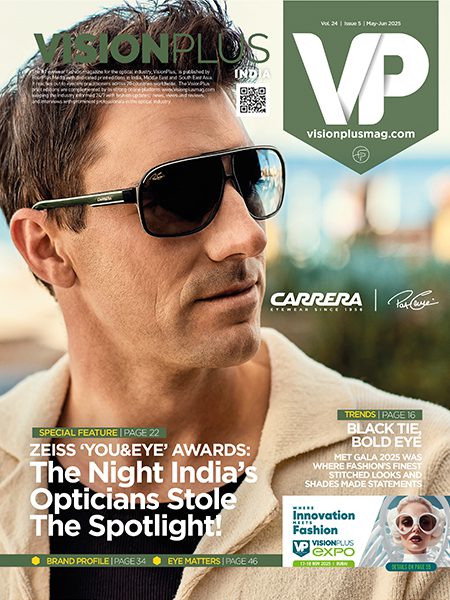
Freeform : A Reference Guide
Everyone seems to be using (or rather misusing) the word ‘freeform’. Pratik Bhatt from Zylux Lenses, sheds some light on this topic
Firstly, let's understand the term freeform. To explain in a non-technical way, freeform technology uses a computer assisted generator. It generates any complex designs directly with the semi-finished base between a hundredth of a dioptre.
Instead of using the traditional method of moving the knife around a single point, this generator is capable of moving around the surface of a spinning lens, incising and shaping the lens where necessary .
The History
The idea behind the power progression in one single lens without the dividing line seen dates back to 114 years ago!
The first patent for a PAL was British Patent 15,735, Though never commercialized, it was granted to Owen Aves with a 1907 priority date. This patent included the manufacturing process and design. Unlike modern PALs, it consisted of a conical back surface and a cylindrical front with opposing axis in order to create a power progression.
While there were several intermediate steps
(H. Newbold appears to have designed a similar lens to Aves around 1913), there is evidence to suggest that Duke Elder in 1922 developed the world's first commercially available PAL (Ultrifo) sold by "Gowlland of Montreal". This was based on an arrangement of aspherical surfaces.
The Carl Zeiss AG & Varilux lenses were the first PAL of modern design. Bernard Maitenaz patented Varilux in 1953, and the product was introduced in 1959 by Société des Lunetiers (now Essilor). The first Varilux lenses' surface structure was however still close to a bifocal lens, with an upper, aberration-free half of the surface for far vision and a rather large "segment" for clear near vision.
The breakthrough in user adaptation and comfort, as well as peripheral and dynamic vision however occurred in 1972 with the introduction of Varilux 2, for which Maitenaz created a totally aspheric design and manufacturing process.
Carl Zeiss AG developed freeform technology in 1983 and then launched their own patented progressive series Gradal HS in 1993.
Early progressive lenses were relatively crude designs. Right and left were identical variable power lenses with distance and reading power centers in the upper and lower part of the lens, respectively.
The glazing was made to accommodate eye position changes from distance viewing to reading. The point of reading is about 14 mm below and 2 mm to the nasal side in comparison to distance viewing. By tilting the reading power towards the nasal side in perfect symmetry, appropriate reading power was given to the wearer.
The symmetric design, however, was difficult to accept and adapt for patients, because the eyes, in general, work asymmetrically. When you look to your right, your right eye views distal (i.e. looking through the lens near to the arm of the spectacles) while your left eye views nasal (i.e. looking through the lens near to the bridge).
Modern sophisticated progressive lenses are designed asymmetrically for greater patient acceptance and include special designs to cater to many separate types of wearer application: for example progressive addition lenses may be designed with distance to intermediate or intermediate to near prescriptions specifically for use as an occupational lens, or to offer enlarged near and intermediate view areas.
The traditional progressive lens is produced from a so-called semi-finished lens. The semi-finished lens is molded with an asymmetrical power pattern on the front. On the back side a custom surfacing is made to adjust the power for each patient. This method is however problematic, especially for astigmatic prescriptions. The reason being that the semi-finished front pattern is designed for a spherical prescription.
Freeform designs are tailored to each prescription and do not have this problem.
Since the 1980s, manufacturers have been able to minimize unwanted aberrations by:
- Improvements in mathematical modeling of surfaces,
- Allowing greater design control;
- Extensive wearer trials; and
- Improved lens manufacturing and measurement technology.
Freeform In The Present
Today the complex surfaces of a progressive lens can be cut and polished on computer-controlled machines, allowing 'freeform surfacing', as opposed to the earlier casting process, thus explaining the difference in price. In short, the price is based on the technology used and the year the lens came to market.
Freeform Process, Personalization And Superior Designs
Lenses, made by freeform technology can produce superior designs, but that does not mean that all such lenses are perfect.
The Freeform process creates potential for perfection, but the lens is as good as its design, the software calculations and the measurements taken.
Even though it was first introduced for progressive users, freeform technology has demonstrated to also be useful for single vision users.
Today, various designs used for single vision lenses use freeform technology to give the user the widest and clearest vision possible without peripheral distortions.
Freeform In The Future
The current spectrum of freeform technology within lenses is still open and constantly growing and progressive lens and single vision designs can be improved with freeform technology
These new progressive designs have managed to eradicate every problem associated with them in the past namely lack of adaptability, peripheral distortions and vertigo.
Today, progressive freeform offers an amplitude of clearer zones wherever the user needs them. Freeform technology has been used in search of personalization, including office lenses and those used for portable digital devices.
Lenses created from free-from technology are perfect for people with active lifestyles, because they appreciate the better optical performance and some designs are currently available in photosensitive sunglasses and even polarized options.
Every lens expert that we have spoken to, as well as those we’ve interviewed, say that the growth of these lenses is increasing in terms of market share. The lens market representatives say that within a few years, lenses using freeform technology will represent the majority of the progressive lens market, with some expecting that they represent 80% or more in sales.
Laboratories continue investing in the necessary equipment in order to produce lenses using freeform technology. So in conclusion though traditional progressives still exist, it’s mainly because of the price segment in some developing and under developed countries.
I personally feel the freeform technology has improved considerably and with measuring tools that take into consideration every aspect of the human eye and vision, the consumers in their 40s seem to prefer the freeform versions rather than the traditional progressives or bifocal lenses.
This in itself shows that there’s more ease of adaptation in a freeform progressive lens compared to other traditional options.
In other words, if you still haven’t familiarized yourself with the conviction of recommending freeform lenses, please make sure you add it to your ‘to-do’ list. Because everything that we know or have learnt from our experience seems to indicate that freeform is the technology that will lead the future.
Pratik Bhatt,
Founder and CEO, Zylux Lenses







